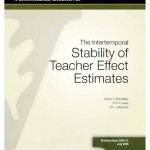The Intertemporal Stability of Teacher Effect Estimates
Recently, a number of school districts have begun using measures of teachers’ contributions to student test scores or teacher “value added” to determine salaries and other monetary rewards. In this paper, the authors investigate the precision of value-added measures by analyzing their inter-temporal stability. They find that these measures of teacher productivity are only moderately stable over time, with year-to-year correlations in the range of 0.2 to 0.3. However, dis-attenuated year-to-year correlations are much higher, suggesting that much of the variation in measured teacher performance is due to random error or “noise” in the average test score gains of a teacher’s students. The authors also find that changes to the specification of the achievement model used to generate teacher effects generally have little impact on the stability of the resulting value-added measures. The one exception being when student covariates are used to represent student heterogeneity rather than student fixed effects; in some settings this resulted in a substantial increase in the cross-year correlation. This indicates there may be non-random assignment of students to teachers based on unobserved student characteristics that can affect the stability of teacher effect estimates. Finally, they re-estimate the achievement model using an alternative test score measure. The observed variation in measured teacher performance in some cases changes significantly across tests, implying that changes in the test instrument over time can affect variability in measured teacher effectiveness as well.
*This paper was presented at the Wisconsin Center for Education Research’s National Center on Value-Added Measurement in March 2008.
To read a copy of this paper, please click here.

Connect with Vanderbilt
©2025 Vanderbilt University ·
Site Development: University Web Communications